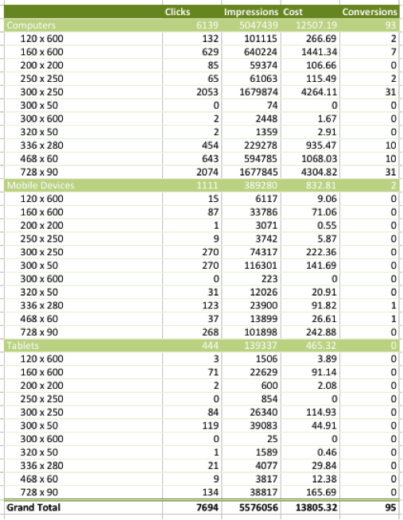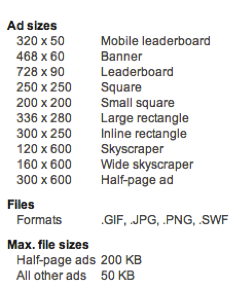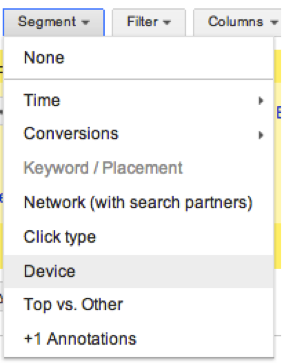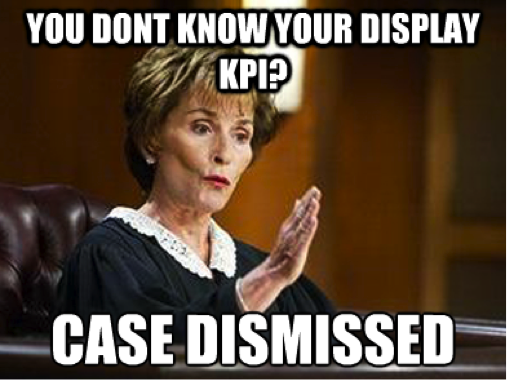For the final part of our January series – Things to test in your account in 2013 – I’m going to be diving into the wonderful world of the Google Display Network, or GDN for those of us who love pointless acronyms!
Anyway, acronyms aside, there are plenty of things you want to be testing in your display campaigns this year. I’d wager that the majority of us in PPC land tend to invest the majority of our collective efforts into the Search Network and spend a little less of our time polishing our display campaigns. That’s the case for me at least – Taking a quick poll around the office it seems that I’m not too far off.
Now, when it comes to testing I like to start with a list of questions and try to tick them off when I know the answers – it helps me build a portrait of where my successful traffic lies. Here is a list of tests to question your account about when it comes to display this year:
1. How differently do my image and text ads perform?
When I set up any new display campaign I normally divide each of my ad groups into two – one for my image ads and one for my text ads. As very different mediums it stands to reason that performance will vary between the two. You should make sure you have a clear understanding of how these two types of ad differ in performance terms for your account. Below I have pulled a relatively simple pivot table in Excel, which groups my ‘Image Ad’ ad groups and my ‘Text Ad’ ad groups into easy to read data.
From this I can see that not only do my image ads tend to get higher CTRs, but also convert at a lower cost than my text ads.
2. Which types of image ads achieve the best results?
Just like with comparing your text and image ads, you should be aware of how the different types of image ad perform in your account. Generally with this I’m looking specifically at whether my static .jpg ads or my moving .gif or .swf ads perform better.
Again, you should be able to work this out from a pivot table in Excel. You might need to be a little cleverer with your original data to get it in an easy to pivot format. I like to add a column after my ‘Ad’ column, and do a text to columns for all data after a period. That should split out your file types.
For this account, it appears there isn’t too much in it – .gifs look better for volume and .jpgs for CPA.
3. Are some of my image ad sizes better than others?
Google currently supports ten different standard sizes for all image ads – you can find these by selecting ‘New Ad’ from within the ‘Ads’ tab of a display campaign and selecting ‘Image Ad’. You should get a ‘see supported specs’ option show up (I’ve included a screenshot to make things a little easier).
It makes sense that some of these sizes will outperform others – the frequency of some of these ad sizes on publishers’ websites will vary, as will the effectiveness at attracting visitors’ gazing eyeballs.
Just as above, this is something you can quickly group using almighty Excel’s pivot tables. As you can see in my example below, performance is remarkably varied across the different sizes. It might be worth it for me to separate my 300×250 ads into their own ad groups and manage their placements and bids separately.
4. How does my display performance vary across different devices?
For best practices I recommend you keep your Desktop, Tablet and Mobile display campaigns separate, but if you haven’t got to that stage yet: When you download your ad report, make sure to get at least one copy that segments by device.
I’ve pulled the exact same pivot table as in question 3, but this time added a further segment.

5. Should I be using frequency capping?
Back in June last year we had a Heroview with John Ellis, in which he made mention of how few advertisers make use of frequency capping in their display efforts. Our very own Sean Quadlin put a good video together that takes you through the process for analyzing your ad frequency. There is a delicate balance you want to have a strategy for – sometimes too much can be detrimental to your brand. At a minimum I tend to set my frequency capping to 10 impressions per user per day.
6. Am I testing out demographic performance?
Unlike in Search, Google Display lets you target by demographics. At present we only have Age or Gender targeting, and there is a certain amount of trust placed in Google to get this right. If my Grandma were searching for Rap Music and skateboarding I doubt Google would have an accurate picture of her demographic.
The easiest way to start gathering data on this is simply to opt into all demographic targeting settings in each ad groups. See Jeff’s post for a more detailed breakdown of demographic bidding options.
7. What type of messaging works best in my ads?
Again, this is a very simple idea that is often not tested in the majority of accounts I see. At a bare minimum you should start with two types of image ads: One that promotes your brand as a whole, and one that focusses in on a specific product or offer you are running. Think about your ads on a hard sell / soft sell level – then run some tests and see!
8. How am I judging my display campaigns?
Funnily enough this seems to be one of the biggest complexities with Display traffic. Unlike search traffic, which is almost always judged on a direct response basis (CPA, ROI, ROAS etc.), people have very differing expectations of their display traffic. Are you running your campaigns for a direct response, are you interested in brand awareness (more impressions = better), or are you doing a hybrid of the two and including view-through conversions as well? Whatever it is, make sure you have decided what your KPI is!
9. Am I making the most of the various targeting options available?
At least once in your Display campaigns’ lives you should have tested variations from each of the available targeting options. These are:
- Contextual – making use of keywords for Google to find placements from.
- Topic – specific lists of websites centered on a topic of your choosing. For a golf resort I’d probably target ‘golf’ as a topic – you get the idea.
- Interest Categories (or ICM) – this is similar to topics but Google creates lists of users it thinks are interested in specific topics rather than websites and markets your ads directly to them. I’m not 100% convinced how accurate these lists are, but you should test them!
- Managed Placements – You can specify to Google specific sites you wish to appear on. Separate out sites that you’ve been appearing on automatically to either exclude them or bid them up depending on results.
10. Have I tried setting up a DCO campaign yet?
If not, you’ve come to the right place! Just last week you were dared to try it out. The Display Campaign Optimizer has had dynamite results in some of our accounts. It’s not a sure thing, but we really recommend giving it a whirl. That linked post should give you all the information you need to get started.
11. Am I being smart with my remarketing efforts?
We could probably write an entire guide just on remarketing *cough*. When thinking about your remarketing make sure you’re not just remarketing to one giant list of all your site users. Be smart by dividing up your user lists by how far down the funnel each of them get – someone who bails from your cart is more valuable than someone who doesn’t interact with your site. Use custom combinations of lists to refine down your remarketing to specific groups and offer them specific incentives. For example – users who got to my shipping page, but didn’t get to my confirmation page might specifically be served ads offering free shipping codes.
On top of that I’d recommend combining remarketing with topics or contextual targeting – this is the path of great CPAs.
Now you have all these questions to ask of your Google Display campaigns, why not put together a way to record your results – either a word doc or a spreadsheet – and work down the list. If you can go from a general all-inclusive display campaign in 2012, to sharply targeted and focussed 2013 ones, the change will be massive.
As always let us know in the comments if you have any other display tricks and tips to share.









